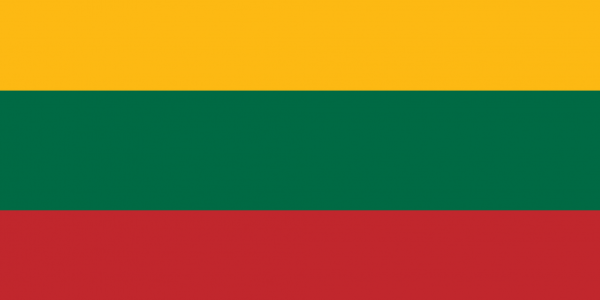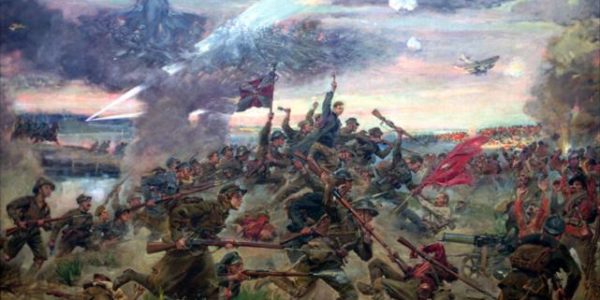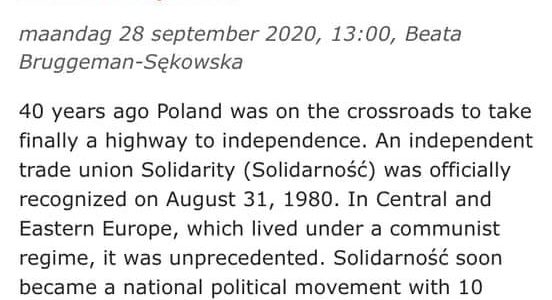Beata Bruggeman-Sękowska
On September 17 about 1 million troops of the Red Army crossed the eastern borders of Poland starting the red invasion of Poland. It was sixteen days after Nazi Germany invaded Poland from the west. The invasion ended on 6 October 1939 with the two-way division and annexation of the entire Second Polish Republic by Germany and the Soviet Union.
On 25 July 1932, Poland and the USSR concluded a non-aggression pact in Moscow. The Polish foreign minister, Józef Beck, did not believe that Joseph Stalin would get politically closer to Adolf Hitler. However, on 23 August in 1939, the Soviet foreign minister Yacheslav Molotov and German foreign minister Joachim von Ribbentrop signed the Molotov-Ribbentrop Pact (Nazi-Soviet Pact). It marked the beginning of one of the darkest periods in the recent history of our continent.
This pact comprised a secret protocol which discussed the partition of central Europe by the two totalitarian states. Even after World War II, many Central and Eastern Europeans continued to suffer under other totalitarian regimes.
This pact facilitated military aggression, annexation of whole states or regions and created the framework conditions for the Holocaust, deportation of nations and social groups, mass murder and ethnic cleansing. To commemorate this history, in 2008 the European Parliament designated August 23 as The European Day of Remembrance for Victims of Totalitarian Regimes.
On 28 September 1939 Warsaw was captured after a heroic Warsaw Siege. Hitler and Stalin trusted that the military campaign in Poland was over. Since Germany took more Polish territories than agreed in the secret protocol they had to revise the conditions. Therefore, a special treaty on borders and friendship was signed, known as the second Molotov-Ribbentrop Pact, in which the Soviet Union agreed to give Germany the eastern part of Mazovia and the Lublin province in exchange for Germany agreeing that Lithuania would be in the Soviet sphere of influence. This meant the brutal partition of Poland and a division of spheres of influence in the Baltic countries.
On the night of February 9-10, 1940 the Soviet Union began genocidal deportations of the Polish population. Polish citizens from eastern Poland were forcefully deported to Siberia and other parts of the Soviet Union. Officers, policemen, civil servants, landowners, members of the middle class or landowning farmers were the first who were deported.
The fourth and last mass deportation ended but a few hours before the German invasion of the USSR in June 1941. In total, around 330,000 Polish citizens: Poles, Jews, Byelorussians, and Ukrainians were deported to Kazakhstan, Uzbekistan and Siberia. Many of them did not survive the journey or their exile in Siberia or Kazakhstan because of unbearable conditions and treatment by the Soviet Union.
Nazi Germany also forced Poles to migrate. By the Spring of 1941, at least 840,000 people were brutally uprooted from their homes and stripped of all their possessions.
From November 1942 to August 1943 300 Polish villages in the Zamosc region where 110,000 Poles lived underwent extremely brutal resettlement. In 1944, after the collapse of the Warsaw Uprising followed the mass exodus of several hundred thousand Varsovians.
In the autumn of 1944 began resettlement of Poland’s eastern lands. Poles who lived to the East of the Bug River (no longer on Polish territory after the Allies changed Poland’s eastern border) were moved Westward, and Polish Ukrainians and Belarusians were sent Eastward.
In the spring of 1940, fulfilling the VKP(b) CC Politburo resolution from 5 March 1940, the Soviet political police – the NKVD of the USSR – has killed nearly 22,000 citizens of the Republic of Poland. Among them there were 14 500 prisoners of war – officers and policemen – from the camps in Kozelsk, Starobelsk and Ostashkov and 7,300 prisoners arrested in the eastern part of the Poland, occupied by the USSR.
The officers from Kozielsk camp were shot in Katyn, those from Starobielsk – in Kharkiv, while the police officers from Ostashkov camp were shot in Kalinin. Execution of prisoners was carried out in prisons in Minsk, Kiev, Kharkov and Kherson. The USSR authorities decided to kill thousands of defenseless prisoners because they did not succumb to the propaganda carried out against them and have remained the ardent patriots, ready to fight for a free Poland with the Soviet occupant.
Source: Central and eastern Europe Center: communications-unlimited.nl




Follow Us!